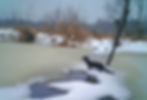Disappearance of European minks and naturalization of American minks in Naliboki Forest
- Vadim Sidorovich
- Mar 24, 2020
- 6 min read
In Naliboki Forest the European mink had entirely disappeared somewhen in the 1970s, nevertheless, the main decline of the local population of the species happened in the mid 1960s. The cause was strong impact of competition with the naturalised American mink that was quite complicated. In the environmental conditions of Belarus the impact consisted mostly of aggressive attacks by the alien mink (mainly males) on both sexes of native minks and, in turn, the latters replaced to very small watercources (which look like a brook) with poor prey supply. Usually in such poor quality habitats mother European mink was not able to catch enough prey for raising kits. Sometimes, pregnant female European minks were turned out from favourable banksides to very unusual habitats for this semiaquatic predator such as either grassy marshes or black alder swamps.

This harsh situation of persecution by alien minks resulted in too high mortality in European mink kits and, so, strong decrease of the population reproduction rate. Therefore, such a deteriorated population disappeared fairly fast as that had happened in Naliboki Forest. Several hunters (e.g. Baliaslaw Sadowski and Tsimokh Satsevich), who lived and trapped minks in Naliboki Forest, evidenced that when the local European mink population was relatively stable, the species density was more or less similar in both smaller rivers and bigger ones, i.e. Nioman and Biarezina. Approximately, according to their words in the majority of cases the population density of the European mink was approximately between 4 and 7 individuals per 10 km of stream stretch in early winters. There were evidences that within Naliboki Forest the last individuals of the European mink persisted in the upper half of Vusa catchment and in the Hal’shanka catchment. Also, several trappers told that male European minks were captured along the Biarezina river even in the end of 1970s.

The American mink is an alien species in Naliboki Forest. To acclimatize the American mink, groups of individuals were released in Naliboki Forest four times during the late 1950s: 100 individuals (75 females) at the Nioman river, downstream of the Biarezina river mouth in 1957; 49 individuals (33 females) at the lake Kroman’ in 1957; 99 individuals (70 females) at the lake Kroman’ in 1958; 99 individuals (69 females) at the confluence of the Vol’ka river and the Biarezina river in 1958. Gradually the alien species had occupied the whole terrain of Naliboki Forest and destroyed the population of the native European mink the terrain-wide. Approximately in 6-8 years, the American mink had occupied the habitat carrying capacity and established dense population there.
Later in the winters of 1982-2003 doing census of American minks in Naliboki Forest, I registered the following range of the species population density: the Biarezina medium-sized river – 17-29 inds/10 km of river stretch; small rivers with natural riverbed (Vol’ka and the upstream of Izliedz’) – 4.3-8.4 inds/10 km of river stretch; small rivers with canalized riverbed (Sivichanka, Zhawtsianka, Pruzhenitsa and Izliedz’ in the downstream and central fragment) – 2.8-5.3 inds/10 km of river stretch. In Naliboki Forest there are plenty of secondary drainage canals that go to rivers with both canalized or natural riverbeds. American minks inhabited such canals too with approximate density of 0.5-3 inds/10 km.

Census of American minks along 18-28 km of Vol’ka river was the most regularly conducted since the winter 1982-1983. Only six out of 29 winters I failed to do reliable counting of American minks there ( see the below Graph). However, for those winters I got quite good expert estimation of the level of the species population density. From the beginning of our census work along the Vol’ka river I faced with quite dense and stable population of the American mink for, at least, 21 years until the autumn of 2003, when this population was crashed by unknown disease. Approximately one out of 5-10 American minks survived through the epidemics. Afterwards this population recovered over three years and then after two years of a relatively high population density similar crash happened again. During two proceeding winters there were recorded very low American mink numbers (the Graph).

The explanation for the crashes in the American mink population may be as follow. In Belarus there were still quite many furbearing farms that specialized in captive-breeding of American minks. In 2000s these farms had relatively low profits and persisted, possibly without sufficient vaccination of American minks against numerous diseases. There were epidemics registered in such a farm. The American minks that have escaped from such furbearing farms brought diseases in feral American minks. Perhaps, in the past vaccination of captive-breeding American minks was on a more regular basis, because cheap soviet vaccines were more available for captive-breeders. Anyway, all the above is only a hypothesis on the population decline.
The second crash in American mink in Naliboki Forest had happened in the autumn of 2008 (see the Graph), and it looks like that until the winter of 2012 the population has more or less recovered.
In the summer and early autumn of 2015 fairly dense population of American mink in Naliboki Forest was registered countrywide. However, in November-December 2015 the American mink population declined rapidly again. Perhaps, in Naliboki Forest on the spring of 2016 there were not more than one American mink per 10 km of the main waterways. Still there are not many American minks in Naliboki Forest. Nevertheless, the species population density during the last years (2018-2020) was markedly higher (3-5 times) than that in the spring 2016.

To investigate the variation in American mink diet in the gradient of stream size in Naliboki Forest, the species scats were sampled along the Biarezina medium-sized river, the Vol’ka small river with natural riverbed (mostly in the downstream) and the upstream of the Izliedz’ small river that looks like a brook. The scats were sampled both in the cold season (November-March) and the warm season (April-October) and in the variety of other situations with prey stock, e.g. population crash and outbreak in crayfish (mainly the narrow-clawed crayfish) or Microtus voles. The data shows the following features. The diet of the American mink in Naliboki Forest characterises the species as generalist predator on both aquatic and terrestrial relatively small vertebrates and big invertebrates at waterway banksides and in their valleys. Mostly the predator species relied on four prey categories: rodents (warm season, hereafter WS – 34.5-46.5% biomass consumed, hereafter %BC; cold season, hereafter CS – 36.2-45.7%BC), frogs (WS – 10.1-25.9%BC; CS – 26.4-44.0%BC), birds (WS – 9.0-24.6%BC; CS – 2.4-4.8%BC), and fish (WS – 7.7-20.5%BC; CS – 3.8-11.0%BC). From the upstream of Izliedz’ river (brook habitat) to the rivers with a higher water abundance (Vol’ka, Biarezina) the portions of fish and birds (mainly waterfowl) increased, whereas the portion of frogs declined. While comparing the warm-season diet and cold-season diet, following seasonal changes were found. In winters compared to summers American minks consumed less fish (3.8-11.0 versus 7.7-20.5%BC) and birds (2.4-4.8 versus 9.0-24.6%BC), but more frogs (26.4-44.0 versus 10.1-25.9%BC). The consumption of rodents was more or less similar: 36.2-45.7%BC in the cold season versus 34.5-46.5%BC in the warm season.
To reveal the changes in diet and population density of the American mink in connection with canalizing of small rivers and draining of swamps in Naliboki Forest (that was mainly conducted in 1960s and 1970s), five model small rivers from the Vol’ka catchment were used for comparison: (1) part of the Vol’ka small river with natural riverbed 34 km long; (2) part of the Izliedz’ small river with natural riverbed 14 km long; (3) the Sivichanka small river with canalized riverbed 15 km long; (4) the Pruzhenitsa small river with canalized riverbed 16 km long; (5) the Zhawtsianka small river with canalized riverbed 22 km long. Presumably the investigated part of Vol’ka, Izliedz’, Sivichanka, Zhawtsianka and Pruzhenitsa were more or less similar small rivers before three of them had been canalized. Also, in Naliboki Forest I censused American minks in 17 more comparable small rivers with natural and canalized riverbeds that belonged to the Biarezina medium-sized river catchment.
From the abundance of data on census of American minks I concluded that in Naliboki Forest after the deterioration of the terrain with draining in the 1970s the species population markedly declined approximately in 3-6 fold in swamped areas that were mostly transformed in agriculture and in 2-4 fold in still forested areas. Later in 1995-1998 and especially in 2006-2007 we recorded the intensive expansion of beavers into the Vol’ka catchment and, particularly, in canalized small rivers and other drainage canals. There was registered further growth of the beaver population there until 2010; density of beaver settlements increased approximately 10-50% in different localities (on average about 30%) there in comparison with the situation in 2006-2007. Having data on the aquatic prey biomass in beaver ponds, we estimated that in 2006-2007 compared to the situation in 1982-1986 creation of numerous ponds by beavers led to the great increase in aquatic prey biomass in all model small rivers: Vol’ka, WS – 2.1 fold; Izliedz’, WS – 14.2 fold; Sivichanka, WS – 329 fold; Pruzhenitsa, WS – 779 fold; Zhawtsianka, WS – 924 fold; Vol’ka, CS – 3.2 fold; Izliedz’, CS – 5.0 fold; Sivichanka, CS – 38.5 fold; Pruzhenitsa, CS – 44.3 fold; Zhawtsianka, CS – 68.7 fold. In the conditions of the considerable increase in aquatic prey biomass, the diets of the American mink changed markedly. Frequency of occurrences of fish in American mink scats grew in both canalized small rivers and small rivers with natural riverbed in the warm and cold seasons. Respectively, the consumption of amphibians by American minks declined there. Taking of the water vole and root vole became much more frequent. In the situation of greatly increased aquatic prey biomass and improved diets (lower consumption of subcaloric amphibians) the numbers of American minks grew along all model small rivers both with natural riverbed and canalized one.
